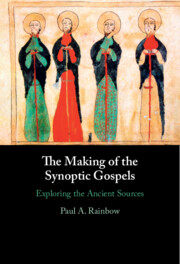Book contents
- The Making of the Synoptic Gospels
- The Making of the Synoptic Gospels
- Copyright page
- Contents
- Preface
- Abbreviations and Symbols
- Note on Color Tables
- 1 Introduction
- 2 State of the Question
- 3 Testimonies of Galilee: Q
- 4 Testimony of the Leaders at Jerusalem
- 5 Embryonic Mark and Matthew
- 6 Luke’s Preparation
- 7 Luke
- 8 Mark
- 9 Matthew (Greek)
- 10 Independence
- Appendixes
- Bibliography
- Indexes
7 - Luke
Published online by Cambridge University Press: 21 November 2024
- The Making of the Synoptic Gospels
- The Making of the Synoptic Gospels
- Copyright page
- Contents
- Preface
- Abbreviations and Symbols
- Note on Color Tables
- 1 Introduction
- 2 State of the Question
- 3 Testimonies of Galilee: Q
- 4 Testimony of the Leaders at Jerusalem
- 5 Embryonic Mark and Matthew
- 6 Luke’s Preparation
- 7 Luke
- 8 Mark
- 9 Matthew (Greek)
- 10 Independence
- Appendixes
- Bibliography
- Indexes
Summary
To round out Luke’s gospel, 29 percent of it runs parallel to three substantial sections of Mark. Analysis shows that Luke’s source was written, differed in hundreds of points from Greek Mark (many of which are seconded by Matthew), involved Luke in translating, and may have contained ambiguities of Semitic vocabulary or syntax in places that might explain divergences among our Greek gospels. A fair inference is that what Luke made selections from and adapted into his final gospel was Hebrew Ur-Matthew.
- Type
- Chapter
- Information
- The Making of the Synoptic GospelsExploring the Ancient Sources, pp. 158 - 193Publisher: Cambridge University PressPrint publication year: 2024

